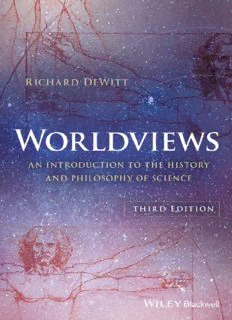Table Of ContentCONTENTS
Cover
Title Page
Copyright
Dedication
List of Figures
Acknowledgments
Introduction
Part I: Fundamental Issues
Chapter 1: Worldviews
Aristotle's Beliefs and the Aristotelian Worldview
The Newtonian Worldview
Concluding Remarks
Chapter 2: Truth
Preliminary Issues
Clarifying the Question
Correspondence Theories of Truth
Coherence Theories of Truth
Problems/Puzzles About Correspondence Theories of Truth
Problems/Puzzles for Coherence Theories of Truth
Philosophical Reflections: Descartes and the Cogito
Concluding Remarks
Chapter 3: Empirical Facts and Philosophical/Conceptual Facts
Preliminary Observations
A Note on Terminology
Concluding Remarks
Chapter 4: Confirming and Disconfirming Evidence and Reasoning
Confirmation Reasoning
Disconfirmation Reasoning
Inductive and Deductive Reasoning
Concluding Remarks
Chapter 5: The Quine–Duhem Thesis and Implications for
Scientific Method
The Quine–Duhem Thesis
Implications for Scientific Method
Concluding Remarks
Chapter 6: A Philosophical Interlude: Problems and Puzzles of
Induction
Hume's Problem of Induction
Hempel's Raven Paradox
Goodman's Gruesome Problem
Concluding Remarks
Chapter 7: Falsifiability
Basic Ideas
Complicating Factors
Concluding Remarks
Chapter 8: Instrumentalism and Realism
Prediction and Explanation
Instrumentalism and Realism
Concluding Remarks
Part II: The Transition from the Aristotelian Worldview to the
Newtonian Worldview
Chapter 9: The Structure of the Universe on the Aristotelian
Worldview
The Physical Structure of the Universe
Conceptual Beliefs about the Universe
Concluding Remarks
Chapter 10: The Preface to Ptolemy's Almagest: The Earth as
Spherical, Stationary, and at the Center of the Universe
The Earth as Spherical
The Earth as Stationary
The Earth as the Center of the Universe
Concluding Remarks
Chapter 11: Astronomical Data: The Empirical Facts
The Movement of the Stars
The Movement of the Sun
The Movement of the Moon
The Movement of the Planets
Concluding Remarks
Chapter 12: Astronomical Data: The Philosophical/Conceptual
Facts
A Scientific Problem with the Motion of the Heavenly Bodies
Could This Account Be Used for a Moving Earth?
Concluding Remarks
Chapter 13: The Ptolemaic System
Background Information
A Brief Description of the Components of Ptolemy's Treatment
of Mars
The Rationale behind These Components
Concluding Remarks
Chapter 14: The Copernican System
Background Information
Overview of the Copernican System
Comparison of the Ptolemaic and Copernican Systems
What Motivated Copernicus?
The Reception of the Copernican Theory
Concluding Remarks
Chapter 15: The Tychonic System
Chapter 16: Kepler's System
Background Information
Kepler's System
What Motivated Kepler?
Concluding Remarks
Chapter 17: Galileo and the Evidence from the Telescope
Background Information
Galileo's Evidence from the Telescope
The Reception of Galileo's Discoveries
Concluding Remarks
Chapter 18: A Summary of Problems Facing the Aristotelian
Worldview
Problems for the Aristotelian Worldview
The Need for a New Science
Concluding Remarks
Chapter 19: Philosophical and Conceptual Connections in the
Development of the New Science
The Size of the Universe
Concluding Remarks
Chapter 20: Overview of the New Science and the Newtonian
Worldview
The New Science
Overview of the Newtonian Worldview
Philosophical Reflections: Instrumentalist and Realist Attitudes
Toward Newton's Concept of Gravity
Concluding Remarks
Chapter 21: Philosophical Interlude: What Is a Scientific Law?
Scientific Laws
Concluding Remarks
Chapter 22: The Development of the Newtonian Worldview, 1700–
1900
Remarks on the Development of the Major Branches of
Science, 1700–1900
Minor Clouds
Concluding Remarks
Part III: Recent Developments In Science and Worldviews
Chapter 23: The Special Theory of Relativity
Absolute Space and Absolute Time
Overview of the Special Theory of Relativity
The Irresistible Why Question
Is Special Relativity Self-Contradictory?
Spacetime, Invariants, and the Geometrical Approach to
Relativity
Concluding Remarks
Chapter 24: The General Theory of Relativity
Basic Principles
The Einstein Field Equations and Predictions of General
Relativity
Philosophical Reflections: General Relativity and Gravity
Concluding Remarks
Chapter 25: Philosophical Interlude: Are (Some) Scientific
Theories Incommensurable?
Preliminary Considerations
Exploring Incommensurability
Discussion: Incommensurability and Scientific Progress
Concluding Remarks
Chapter 26: Introduction to Quantum Theory: Basic Empirical
Facts and the Mathematics of Quantum Theory
Facts, Theory, and Interpretation
Some Quantum Facts
Overview of the Mathematics of Quantum Theory
Concluding Remarks
Chapter 27: The Reality Question: The Measurement Problem and
Interpretations of Quantum Theory
The Measurement Problem
Interpretations of Quantum Theory
Concluding Remarks
Chapter 28: Quantum Theory and Locality: EPR, Bell's Theorem,
and the Aspect Experiments
Background Information
The EPR Thought Experiment
Bell's Theorem
Aspect's Experiments
Locality, Nonlocality, and Spooky Action at a Distance
Concluding Remarks
Chapter 29: Overview of the Theory of Evolution
Overview of the Basics of Evolutionary Theory
Darwin's and Wallace's Paths to Natural Selection
Concluding Remarks
Chapter 30: Reflections on Evolution
Implications for Religion
Morality and Ethics
Empirical Studies
Concluding Remarks
Chapter 31: Worldviews: Concluding Thoughts
Overview
Reflections on Relativity Theory
Reflections on Quantum Theory
Reflections on Evolutionary Theory
Metaphors
Chapter Notes and Suggested Reading
References
Index
End User License Agreement
List of Tables
List of Illustrations
Figure 1.1
Figure 1.2
Figure 2.1
Figure 2.2
Figure 2.3
Figure 5.1
Figure 8.1
Figure 10.1
Figure 10.2
Figure 13.1
Figure 13.2
Figure 13.3
Figure 13.4
Figure 13.5
Figure 14.1
Figure 14.2
Figure 15.1
Figure 16.1
Figure 16.2
Figure 16.3
Figure 16.4
Figure 16.5
Figure 16.6
Figure 17.1
Figure 17.2
Figure 17.3
Figure 17.4
Figure 17.5
Figure 17.6
Figure 17.7
Figure 22.1
Figure 22.2
Figure 23.1
Figure 23.2
Figure 23.3
Figure 23.4
Figure 24.1
Figure 24.2
Figure 26.1
Figure 26.2
Figure 26.3
Figure 26.4
Figure 26.5
Figure 26.6
Figure 26.7
Figure 26.8
Figure 26.9
Figure 26.10
Figure 26.11
Figure 26.12
Figure 26.13
Figure 26.14
Figure 27.1
Figure 27.2
Figure 28.1
Figure 28.2
Figure 28.3
Figure 29.1
Figure 30.1
Figure 30.2
Figure 30.3
Description:PRAISE FOR PREVIOUS EDITIONS "This is a brilliantly clear introduction (and indeed reframing) of the history and philosophy of science in terms of worldviews and their elements…. In addition, the book is incredibly well-informed from both a scientific and philosophical angle. Highly recommended."S

